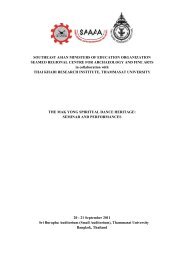on Culture & Development - Seameo-SPAFA
on Culture & Development - Seameo-SPAFA
on Culture & Development - Seameo-SPAFA
- No tags were found...
You also want an ePaper? Increase the reach of your titles
YUMPU automatically turns print PDFs into web optimized ePapers that Google loves.
2. Invite volunteers to explain briefly how they go aboutidentifying stakeholders in their work and how they usethe informati<strong>on</strong>.3. Ask participants to form groups of 4-5 people. Eachmember of the group briefly outlines a project they areworking <strong>on</strong>. The group then selects <strong>on</strong>e of thesepossibilities and works together to c<strong>on</strong>duct a stakeholderanalysis for that project, recording the informati<strong>on</strong> <strong>on</strong>flipchart paper.4. Display the informati<strong>on</strong>, including project title, so that theparticipants from other groups can comment / add stakeholdersthey feel are missing. The lists should include potentialpartners, supporters and opp<strong>on</strong>ents, those directlyor indirectly affected by the project, as well as those withrelevant skills, resources or abilities.655. In the original groups, and with reference to the selectedproject, invite participants to identify the different c<strong>on</strong>textsor occasi<strong>on</strong>s which may bring the different stakeholdergroups together.6. Ask them to anticipate what issues may arise between thedifferent stakeholders <strong>on</strong> such occasi<strong>on</strong>s and to note thesedown.7. Ask participants to analyse the notes they have taken andto see if they can group these problems in any way.8. Elicit feedback from each group.9. Introduce the importance /influence grid and askparticipants to place their stake holders within this grid.










